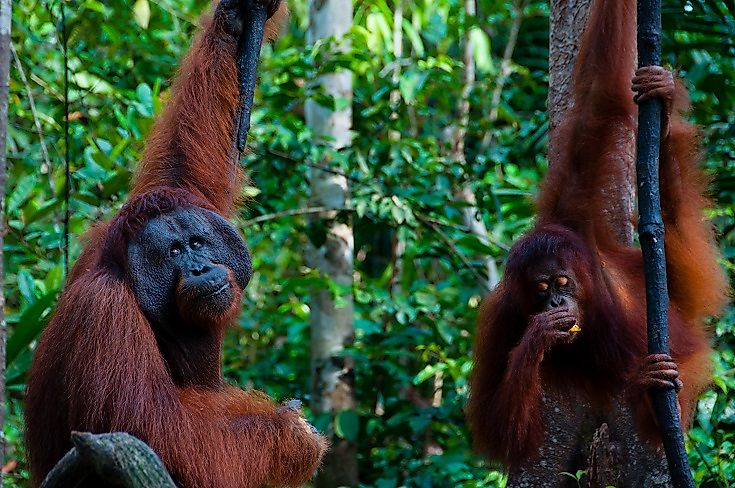What and Where Is Kalimantan?

6. Description
Three-fourths of the island of Borneo (the third largest island in the world) is politically controlled by Indonesia, and this portion of the island is known as Kalimantan. The remaining part of Borneo is under the control of Malaysian states of Sabah and Sarawak, and the Sultanate of Brunei. Kalimantan is divided into four provinces, the largest of which is Central Kalimantan, or Kalimantan Tengah, with an area of 153,564.50 square kilometers. The other three provinces are West Kalimantan (Kalimantan Barat), East Kalimantan (Kalimantan Timur), and South Kalimantan (Kalimantan Selatan). The population of Kalimantan makes up about 69.5% of the total population of Borneo, and therefore, given that about 73% of Borneo's territory lies in Kalimantan, this portion of the island is slightly less densely populated than the island's average.
5. History
Hinduism and Buddhism appear to have had significant influences on Kalimantan since the ancient times. Evidence of Hindu and Buddhist culture have been recorded here in the form of Sanskrit scriptures and Buddhists and Hindu statues and literature dating as far back as to between the 5th and 11th Centuries. The Srivijaya Empire of Sumatra (7th to 14th Centuries), the Majapahit Empire of eastern Java (14th to 16th Centuries), and then the Muslim states (following the 16th Century) held control over Kalimantan at different points of time. The Dutch and the British started arriving onto the scene from the 17th Century onwards and, by 1863, Kalimantan was under Dutch colonial rule. World War II witnessed Japanese occupation of the island of Borneo. Finally, after an Indonesian Independence movement, Kalimantan achieved its freedom from the Japanese forces in 1945, and in 1949-1950 became a part of the Republic of Indonesia.
4. Economy and Government
Since over 75% of Kalimantan’s territory is occupied by forests, forest-based industries contribute largely to the region’s economy. Agriculture and fishing are the other major economic sectors of Kalimantan. Timber, plywood, processed wood, veneer, rattan, resin, rubber, and fish are some of the major export products of the region. The four provinces of Kalimantan are currently under the rule and jurisdiction of the Republic of Indonesia.
3. Culture
As per the 2010 Census of Indonesia, the population of Kalimantan was 13,772,543. Most of the area's settlements are based along the coastline, and their populaces mainly comprised by ethnic Malay populations which are predominately Muslim, along with a significant minority of about 50 ethnic Dayak groups who live in the interior regions in longhouses alongside streams or rivers. The Dayaks were traditionally hunter-gatherers, and today "slash and burn" agriculturalists, and were popularly known as the “headhunters of Borneo”. As per the Dayak tradition, the heads of their enemies carried supernatural powers that will ensure their well being. Hence, the more heads a tribesman could collect, the higher was his rank in the traditional Dayak community. Though this practice was outlawed by the Dutch in the 19th Century, today the popular tales of terror of these head hunters still attract a large number of tourists to visit the Dayak settlements in Kalimantan.
2. Habitat and Biodiversity
The rainforests, montane forests, mangroves, and swamps of Kalimantan and its tropical climate support the survival and growth of a diverse variety of flora and fauna. Of the 15,000 plant species found in these forests, nearly 6,000 are endemic in nature. 10 species of primates, 350 species of birds, and 150 amphibian and reptilian species inhabit the forests of the region as well. A large number of national parks, reserves, and sanctuaries have also been established here. Orangutans are the flagship species of these forests, while Malaysian Sun bears, Leaf monkeys, macaques, and pangolins can also be spotted in the forests. Strikingly beautiful birds, like the Sun birds, cockatoos, hornbills, and pheasants, can also be observed here. Insects thrive in the forests of Kalimantan, and spectacular butterflies, metallic beetles, millipedes, and Walking Stick insects form a thriving invertebrate community in the diverse habitats of Kalimantan.
1. Environmental Threats and Territorial Disputes
The forests of Kalimantan are currently facing severe threats from unscrupulous logging companies, who often illegally clear out vast tracts of pristine forests for meeting the demands of the expanding global markets for timber. Tropical hardwood trees are being cut down at a rapid pace, only to be replaced by vegetation of commercial interest, like rubber plantations and monoculture (single-crop) palm tree plantations for producing palm oil. Over 30% of Borneo’s primary rainforests have been lost over the past 40 years, and many of its rare and endangered endemic species are facing the risk of extinction as a consequence.











